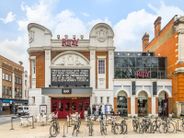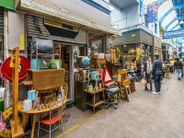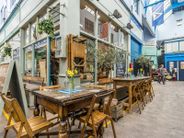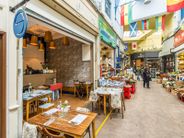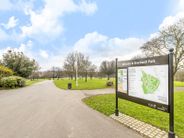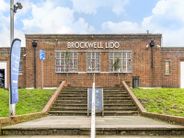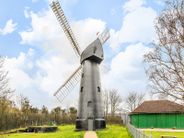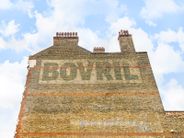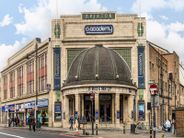
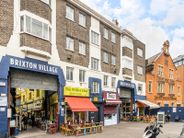
Brixton
Average sold price last 12 months
£580,041
What’s it all about?
As any long term resident will tell you, Brixton has changed. Once best known for its community of lively locals and fried chicken shops, it has emerged as a destination for food lovers and a neighbourhood that harnesses the power of its energetic community for the common good. The area around the market – or ‘Brixton Village’ as it’s recently been dubbed – positively buzzes with a mix of born and raised residents, hip youngsters and growing numbers of families. Brixton Market is the very epicentre of life here, and you can usually buy anything from ackee and saltfish to fromage and champagne. The town will always be famous for its music venues, and things can get hectic on gig nights at the Academy, but life away from the main drag is calm. Spacious Victorian terraces, lovely local pubs and award winning parks on the doorstep are all features that attract families who aren't ready to leave the thrills of London behind them. Aside from its lively nightlife, Brixton is increasingly home to more grown up attractions, with a popular arthouse cinema and several galleries, so despite its great transport links to central London most residents see no need to leave at weekends.
Fact file
- London’s first department store, Bon Marche, was built in Brixton in 1877.
- Brixton Windmill, one of only a dozen working mills in London, was reopened in 2011 after a Lottery grant and the tireless work of a local community group.
- In 1880 Electric Avenue was so named when it became the first street in London to be lit by electricity.
- The town has its own currency, the Brixton Pound, an alternative to sterling launched in 2009 for spending exclusively in local shops with the aim of boosting the local economy.
Architecture and property
The coming of the railways linked Brixton with the centre of London in the 1860s and during this time large family houses were built along the main roads. Most of these were converted into flats and boarding houses at the start of the 20th century as the middle class were replaced by an influx of the working class. By 1925 Brixton housed the largest shopping centre in South London, as well as a thriving market, cinemas, pubs and a theatre. However, the post war period was one of decline, followed by slum clearances and the building of council housing. Period housing tends to be late Victorian, although there are pockets of early Victorian. Terraced houses dating from the 1920s can be found where Brixton meets Tulse Hill and the roads around Elm Park Road make up a little enclave that contains some charming cottages. The area around Loughborough Junction station has large four storey houses, mostly converted into flats.
For house price information please visit the sold data tab.
Going out
Eating: Brixton’s multicultural heritage is reflected in the local cuisine. Try sourdough pizza at the original Franco Manca, or venture into the vaulted crypt of St Matthew’s Church for tapas at Gremio de Brixton. This is the area for getting adventurous with your palate – try Caribbean cuisine at Negrill and Fish Wings and Tings. Try your hand at Indonesian cooking at Satay Bar and for the best BBQ food in town, check out Blues Kitchen.
Drinking: Brixton has seen an explosion of new bars. Dogstar, Brixton Jamm and Lost in Brixton are meccas for the younger crowd. Effra Social is a vintage themed bar that hosts cinema nights and pinball tournaments. But there are still plenty of good old fashioned pubs here, with the Duke of Edinburgh and the Trinity Arms long time favourites. For the summer months, Pop Brixton offers a plethora of bars and restaurants designed in shipping containers.
Cinema: The Ritzy Cinema was designed as the Electric Pavilion in 1910 and was one of England’s first purpose built picture houses. It shows the latest big movies, as well as arthouse and foreign language films.
Music: The renowned O2 Brixton Academy is one of the biggest non arena venues in the Capital. For music and club nights on a slightly smaller scale, head for Electric Brixton or Phonox.
Culture: Brixton theatre and the Landor Theatre in nearby Clapham specialises in producing little-known musicals in its intimate 60 seat space. Brixton Art Gallery has been resident here for more than 20 years and the area is also home to the Black Cultural Archives, which offers insight into the history of people of African and Caribbean descent in Britain.
Local amenities
- The Granville Arcade, just off the high street, was renamed ‘Brixton Village’ and is now home to a host of shops and cafes. Spoilt for choice for eateries, shoppers can treat themselves to Honest Burgers, BBQ food from Joint, Thai food from Koa Sarn and tapas small plates from Bottle + Rye.
- Brixton is a market lover’s heaven. The main market sells every kind of fruit, veg, meat and fish you could ever wish for during the week, with the addition of themed events at the weekends, such as a vintage market and a flea market. There is also a night market held on Windrush Square every two months.
- Brixton is home to several chain stores, including the venerable Morleys department store, Marks & Spencer, H&M and Boots. There is also a large Tesco on Acre Lane.
- Brixton Leisure Centre has been refurbished and now offers a swimming pool, climbing wall, squash and badminton courts, as well as fitness classes for all ages. The area is also home to a 1970s purpose built skatepark, known locally as Brixton Beach.
- Brixton Library offers reading clubs, book sales, free WiFi and a selection of foreign language books.
Green spaces
Brockwell Park is a Green Flag award winner and straddles Brixton and nearby Herne Hill. At 125 acres it is one of the largest green spaces in this area and includes Brockwell Lido, which also has a poolside cafe and full gym facilities. In July the park is also home to the Lambeth Country Show, one of the largest free community festivals in Europe, which includes farm exhibits, funfair and live music. Running parallel to Brixton Road, Max Roach Park includes a nature trail that extends to Rush Common, forming a green corridor through the heart of the area.
Transport
Tube: Brixton is the southern terminus of the Victoria Line, meaning that it’s often possible to get a seat at the start of the journey into town. The Tube takes seven minutes to reach Victoria and ten minutes to get to Oxford Circus.
Rail: Southeastern runs services to Victoria (four trains an hour) and towards Orpington in Kent from Brixton rail station.
Bus: It’s possible to get almost anywhere in London from Brixton by bus, with some of the main routes being the 2 (Marylebone), 3 and 35 (Oxford Circus), 45 and 59 (King’s Cross), 133 (Liverpool Street), 159 (Marble Arch), 196 and 415 (Elephant & Castle), 109 and 250 (Croydon).
Road: There is such a wealth of public transport in Brixton that most locals prefer not to use a car. There is, however, some free and some pay and display parking available in the side roads around the stations.
Cycle: There are several bike shops offering repairs, the most well known of which is the workers’ co operative Brixton Cycles.
Education
Primary school options in Brixton include Sudbourne Primary, Corpus Christi Catholic School, and St John’s Angell Town Church of England School. The Evelyn Grace co ed state secondary has a good reputation, as does The Lambeth Academy, and the new Trinity Academy is a Catholic secondary. The Michael Tippett School specialises in children with a range of disabilities, particularly those on the autistic spectrum. The well known independent schools in Dulwich are also within easy reach.
Please see our schools tab for more information on schools in this area.
If you’re looking to buy, sell, rent or let in Brixton, contact your local KFH branch today.
Find a property
Looking for a property valuation?
Get an accurate, no-obligation valuation from our local experts.
